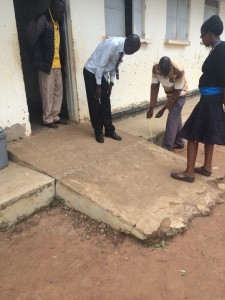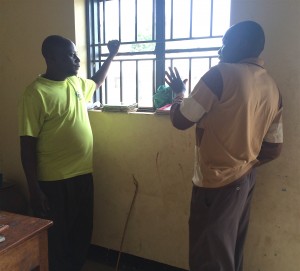While my time at the GDPU is winding down, Patrick and I have been planning the schedule and goals of our next few weeks. One thing that has become clear to me during this time is that the issue of ensuring children with disabilities get a quality education is a complex one. I came here with the intention of building a toilet and couldn’t fully grasp all that goes into it until I spent some time here. The schools definitely need an accessible toilet but there are a lot of other things needed at schools as well. So how do we make the students, teachers, parents and community as a whole realize the importance of inclusion and the rights of children with disabilities? The key to building an inclusive environment is bringing all of them together and the toilet is the tangible piece that can bring them together but it isn’t the only component to it.
Let me backtrack for a minute. When Patrick and I went to visit the rural schools we found various rates of enrollment among children with disabilities in each but an overarching theme from all of the teachers were that there were more children with disabilities in the community who just didn’t come to school. I had mentioned in a previous blog that the roads to schools were pretty treacherous and that just getting to class would be a challenge for a child with a disability. That’s part of what keeps many children from getting an education. Another big piece is something that Patrick articulated to me in one of our planning conversations “In our community, having a disability is seen as a curse.”
Patrick has been working with the GDPU for many years and has seen A LOT. I learn so much from him just listening to stories about people he has worked with. He said that in some of the communities we went to visit, he knows there are lots of children with disabilities around but noted that many parents feel it’s best to keep them at home..or better put..hidden. He says that sometimes, “parents just pray for their child with a disability to die” because of the burden it brings to the family. That’s a pretty heavy thought and something that is engrained in the community with no easy way to change.
It’s hard to know the best entry point to begin to tackle some of these things and it certainly won’t be solved by the time I leave here this summer. This project is at a good starting point- the schools, which can lead us to the larger community. Our project seeks to create a safe and healthy school environment and prevent children with disabilities from dropping out by improving the structure (enter the toilet) as well as educating teachers and students about inclusion
Although the toilet is not going to be built in a school this year, Patrick and I have already started an important piece of the next steps and that’s engaging the schools. We have their interest and they know we want to help. We are identifying the next schools that we want to bring an accessible toilet/inclusion training to and we plan to continue the engagement process while I’m here
There is another area that may not be the main focus of the project but can begin to be touched on, and that is encouraging children with disabilities in the community to come to school. We plan to meet with members of the community in the school districts who have children with disabilities but aren’t bringing them to school to try to find out why. Is it a transportation issue? Is it a problem with the school faculty? Is it an issue that the family is ashamed? The GDPU may not be able to fix all the problems with this project but we can start a dialogue and go from there. We can let them know that there are people that want to help and want to do what we can to ease their needs.
The big picture is incredibly complicated and overwhelming. In the days that I become frustrated with my inability to do more It helps to remember that this all has to start somewhere. Having conversations and getting to understand someone’s perspective is important to letting them know you are interested in what is going on with them. As a Social Worker the most important thing I’ve learned is establishing a relationship is crucial to being able to provide any kind of support. I think these next few weeks I need to shift my thinking back to my social work experience and focus on my interactions with others and work to get the most meaning out of each exchange that I can.
Posted By Amy Gillespie (Uganda)
Posted Jul 24th, 2016



